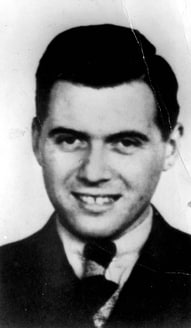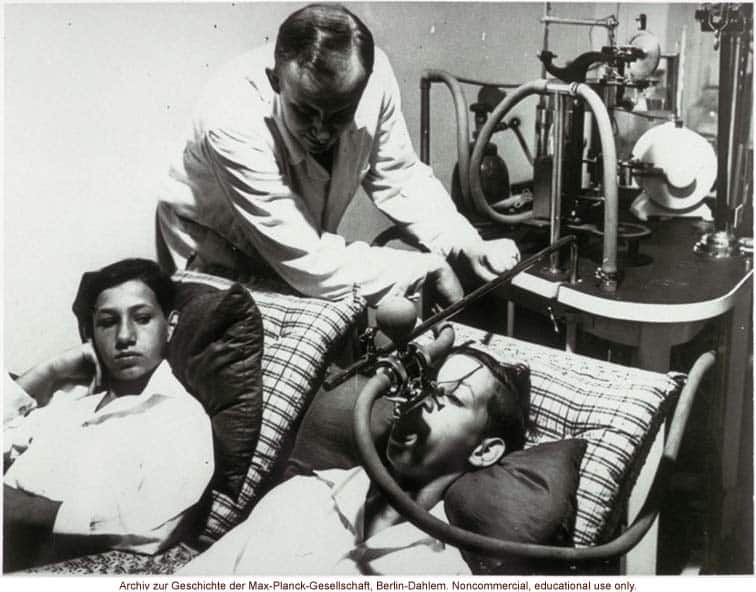
The prisoners called him the Angel of Death. Children called him Uncle Pepi. Who was this man, Josef Mengele? Born on March 16th, 1911 to a well-to-do family, Josef Mengele was a handsome young man with a bright future. After finishing college, he joined the Waffen-SS and was stationed at Auschwitz where he conducted his medical research.
Survivors of the holocaust often recalled him as an impeccably dressed man always present at selections carrying his riding crop; a wave to the left meant survival in the slave labour force, and a wave to the right condemned prisoners to the ghastly death in the gas chamber. (Lynott)
Presented with a myriad amount of human subjects in an environment that asked for no moral implications, Mengele quickly set to work torturing and murdering the prisoners of Auschwitz-Birkenau with complete disregard to the effects the experiments would have on the subjects. He had no respect for humans as individuals. Josef Mengele saw human life as nothing more than a replaceable plaything for entertaining his demented curiosity. (Lifton)
Mengele found elation in the spilling of blood and the infliction of pain, much like a child finds delight in watching his favorite show on television. Killing was to Mengele as any leisure activity; a way to relax and pass the time. It had become a form of entertainment that Mengele relished in. Gisella Perl, an inmate doctor who worked for Mengele in Aushwitz-Birkenau, recalls an incident when a woman attempting to escape for the sixth time from a truck transporting prisoners to the gas chamber was caught by Mengele.
He grabbed her by the neck and proceeded to beat her head to a bloody pulp. He hit her, slapped her, boxed her, always her head — screaming at the top of his voice, “You want to escape, don’t you. You can’t escape now. You are going to burn like the others, you are going to croak, you dirty Jew.” As I watched, I saw her two beautiful, intelligent eyes disappear under a layer of blood. And in a few seconds, her straight, pointed nose was a flat, broken, bleeding mass. Half an hour later, Dr. Mengele returned to the hospital. He took a piece of perfumed soap out of his bag and, whistling gaily with a smile of deep satisfaction on his face, he began to wash his hands. (Lynott)
Humans all seek pleasure and satisfaction, but to what extent will they go to attain it? Surely not at the cost of another man’s life. Mengele’s venture into his brutalities ridded him of humanity and the ability to see humans as individuals with thoughts and feelings, and that was what made him so frightening.
The Angel of Death had the job to kill, and those unfortunate enough to be murdered by him were done so in the most appalling manner, for it was the grisly suffering of men that brought Mengele the thrill and excitement he sought after. How else does one explain the unnecessarily painful ends he subjected his victims to? Humans were replaceable, and very much at his disposal, so he played with them like toys, and disposed of them when they were too damaged to be of use. Seventy-eight different indictments charging Mengele with the most heinous and bestial crime against humanity was drawn up in 1981, by the West German Prosecutor’s Office:
Having actively and decisively taken part in selections in the prisoners’ sick blocks, of such prisoners who through hunger, deprivations, exhaustion, sickness, disease, abuse or other reasons were unfit for work in the camp and whose speedy recovery was not envisaged… Those selected were killed either through injections or firing squads or by painful suffocation to death through prussic acid in the gas chambers in order to make room in the camp for the “fit” prisoners, selected by him or other SS doctors… The injections that killed were made with phenol, petrol, Evipal, chloroform, or air into the circulation, especially into the heart chamber, either with his own hands or he ordered the SS sanitary worker to do it while he watched. (Lynott)
There was no mercy nor moral in this man, who would cross any line to get what he wanted. There were far more efficient ways to kill, and much less painful ways too — yet, the Angel of Death killed his victims in the most appalling methods. Mengele did not kill simply to kill; he killed to quench his unending thirst for watching others suffer at his bloodstained hands.
Those selected to perish by the Angel of Death had become a mass of bodies to him; they were no longer individuals with thoughts and feelings — they never were. They were a minor nuisance for the busy Mengele, useless bodies too damaged to be experimented on, waiting to be dealt with in the most efficient way so the camp could continue running. Once, when the crematoria became too crowded to accommodate the innumerable Jews flowing into the camp, Mengele had trenches dug, filled with gasoline and set afire.
He supervised as prisoners — dead and the living — were thrown into the blazing pits. On another occasion, Mengele burnt children. SS officers and Mengele surrounded a fire, waiting for trucks to arrive. After a while, about ten dump trucks arrived, carrying children. The trucks backed up to the fire, and officers started throwing the children into the roaring pit of flames.
The children fought and scream; some managed to crawl out. Officers continued with their jobs, fueling the fire with the bodies of children and pushing back those who managed to crawl out with sticks as Mengele gave orders. The fire was fed and stoked as Mengele watched with mild interest. Perhaps in his eyes, it was just SS men throwing coals into a blazing pit and stoking the fire with their sticks.
How does one witness the burning of children and observe with such serenity? It must be that Mengele could no longer see men as living individuals; they were either good for labour, good for experiments, or good for nothing and sent to their deaths. (Lynott)

Of all the experiments and torturous murder Mengele conducted in Auschwitz, he was perhaps most notorious for his research and experiment on twins, and how he treated them in the most humiliating and degrading ways during his experiments.
Twins were first stripped naked and laid side by side so that each and every part of their bodies could be measured, compared and analyzed. This procedure lasted hours. Their hair and eyelashes were counted (Pogrebin), their eyes were examined, foot and hand prints taken — they were poked and prodded, and left stripped of any dignity. “The experiments were difficult in that they were degrading and made us feel like animals.”
Recalls Eva Mozes Kor, survivor of Mengele’s experiments, “I was photographed continuously. Photographed and compared, always in the nude. The humiliation was the closest thing to making someone feel like a nothing, a piece of garbage, a piece of meat.” As some twins underwent experiments, they were not given proper accommodation. Vera Kregel, a twin Mengele operated on, recalls: ” And then they took my mother, my sister, and me and another set of twins and put us in a cage.
Like a cage for animals, it was only one or two meters. We couldn’t move at all. We were cramped like animals in a cage. We stayed like that for ten days.” (Grodin, Mozes Kor and Benedict) After the tedious procedures of measuring, twins were subjected to injections of unknown substances and surgeries. In attempt to create blue eyes, Mengele injected chemicals and dyes into the eyes of his subjects without anesthesia, which often resulted in severe pain, infections, temporary or permanent blindness (Rosenburg).
Injections and X-rays were given and blood was drawn on a daily basis (Grodin, Mozes Kor and Benedict). Surgeries like vivisections, inner organ removal, amputation and castration were done without anesthesia. If one twin was to die due to an experiment, the other would be immediately killed so that their autopsies could be compared (Lynott).
Surely, if Mengele had seen these subjects as humans he would not have treated them in such ways. The victims were merely guinea pigs, caged up and stripped of dignity, experimented on, and then murdered per his orders without so much as a glance of pity sent in their direction.
The Angel of Death was a man whose devotion to Nazi ideology drove him mad. His pursuit of genetic information that had no real basis except in the minds of Aryan supremacists compelled him to cross the boundaries of morality, and conduct biological research that was no longer for the benefit of men, but for the appeasement of his own demented curiosity.
What made Josef Mengele into such a man — the Angel of Death? The answer may never be known, for he eluded capture from the authorities. Still today, Josef Mengele remains an enigma, and scholars will never stop wondering how a man could display such inhumanity, and how tragedies like it can be stopped. There is nothing to be done now except to remember the ones who perished at the hands of Josef Mengele and hope and pray that history does not repeat itself.
